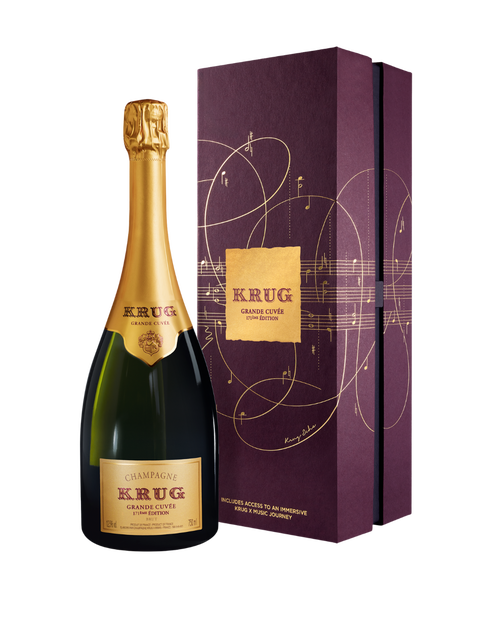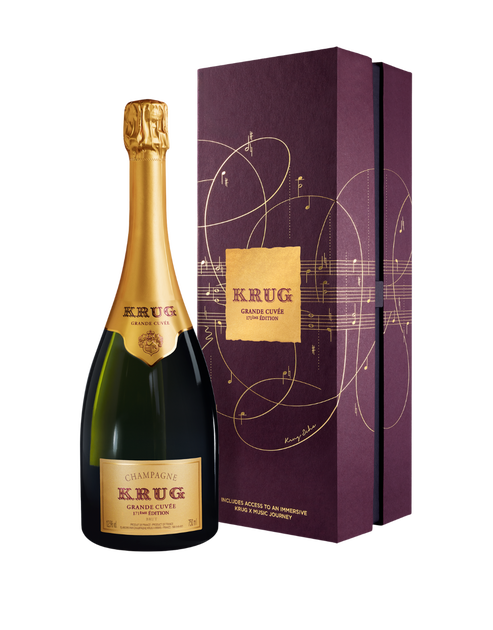1
/
of
1
- Home
- Black Friday Preview - Luxury Wines
- Krug Grand Cuvee 171eme Edition Music Gift Box (Echos) - NV (750ml)
Krug Grand Cuvee 171eme Edition Music Gift Box (Echos) - NV (750ml)
Krug Grand Cuvee 171eme Edition Music Gift Box (Echos) - NV (750ml)
Regular price
$314.99
Sale price
$314.99
Regular price
$314.99
Unit price
/
per
A vivid Champagne, with chiseled acidity and a fine, vivacious mousse creating a buoyant frame for layered flavors of crushed black raspberry, grilled nuts, pink grapefruit sorbet and coffee liqueur, plus fragrant accents of ground ginger and anise, graphite and lime blossoms. Long and expressive on the finish, crackling with a lingering fleur de sel note. Pinot Noir, Chardonnay and Meunier. Disgorged winter 2022 to 2021. Drink now through 2033. - Alison Napjus
Availability:
3 In Stock
$25 Shipping on Orders +$299
Couldn't load pickup availability
Share :

- varietal
- Region
- Type
- Reviews
Product Review
The complex nose of grain, biscuit, citrus and honey indicates some use of wood, while the palate is tight and elegant. What's most impressive is the texture, all filigree and finesse, from start to finish. An elegant version, with subtle intensity and length.
Pinot Noir is responsible for some of the world’s finest wines. Famed for producing the red wines of Burgundy and the Côte d’Or in particular, it is now widely grown in cool climates across Califonia and Oregon, and with increasing success in New Zealand. Although typically used to produce varietal wines, Pinot Noir makes a significant contribution in the wines of Champagne, where it is vinified as a white wine and blended with Cardonnay and Pinot Meunier. On the whole, fresh summer fruit of strawberries, raspberries and red cherries tend to be the identifying qualities, however richer versions express darker fruit including black cherries (kirsch), cherry cola, leather and violets to name a few.
Champagne was the first region in the world to start producing sparkling wine on a commercial level and where most New World producers look to for inspiration. Producing a fizzy wine often occurred by accident, and was, for a long time seen as a detriment with producers going to great lengths to prevent a second fermentation. Due to the marginal climate the temperature in the fall would often dip, sedating the yeasts before all the sugars were converted into alcohol. When the region warmed up the following spring the unfermented sugars occasionally spurred on a second fermentation trapping the carbon dioxide (a by-product) in the bottle . It wasn’t until the turn of the 19th century that sparkling wine became popular and desirable. The region is split into four regions. Three are adjoining: The Montagne de Rheims to the north, the Cotes de Blanc to the south, and the Marne Valley in between. The fourth and separate region is the Cote des Bar in the Aube valley, some 70 miles south of Epernay.
Sparkling wine is a wine with high levels of carbon dioxide in it making it bubble. The carbon dioxide is a result of natural fermentation, either in a bottle or a specially designed tank, or as a result of carbon dioxide injection.Sparkling wine is usually white or rosé but there are many examples of red sparkling wines. The sweetness of sparkling wine can range from very dry "brut" styles to sweeter "doux" varieties.When one thinks of sparkling wine they usually think of Champagne, but this wine is exclusively produced in the Champagne region of France and many sparkling wines are produced in other countries and regions. Most countries reserve the word Champagne for a specific type from the Champagne region of France. The French terms "Mousseux" or "Crémant" are used to refer to sparkling wine not made in the Champagne region. German and Austrian sparkling wines are called Sekt. The United States is a significant producer of sparkling wine with producers in numerous states. Recently the United Kingdom, which produced some of the earliest examples of sparkling wine, has started producing sparkling wines again.


